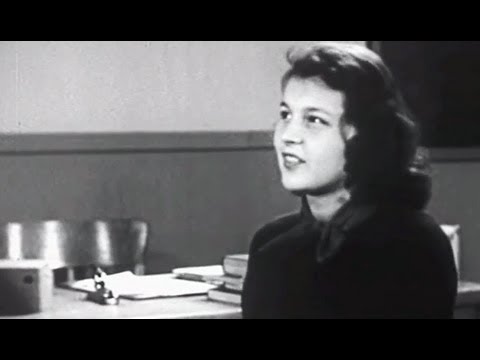more at
‘Biology teacher explains emotions, voluntary and involuntary behavior…
Biology teacher shows pupils how they react differently to same situation. Discusses what emotions are, what they do, where they come from, and how they are changed. Effects of emotions on voluntary and involuntary behavior.
Ken Smith sez: “Mr. Brent” teaches three teens (including John Galvarro, star of Drug Addiction) about emotions, with the help of a big plastic brain on his desk. Even more Skinnerist than Control Your Emotions, and much less entertaining.’
NEW VERSION with improved video & sound:
Public domain film from the Prelinger Archives, slightly cropped to remove uneven edges, with the aspect ratio corrected, and mild video noise reduction applied.
The soundtrack was also processed with volume normalization, noise reduction, clipping reduction, and/or equalization (the resulting sound, though not perfect, is far less noisy than the original).
Wikipedia license:
In psychology and philosophy, emotion is a subjective, conscious experience that is characterized primarily by psychophysiological expressions, biological reactions, and mental states. Emotion is often associated and considered reciprocally influential with mood, temperament, personality, disposition, and motivation,[citation needed] as well as influenced by hormones and neurotransmitters such as dopamine, noradrenaline, serotonin, oxytocin, cortisol and GABA. Emotion is often the driving force behind motivation, positive or negative. An alternative definition of emotion is a “positive or negative experience that is associated with a particular pattern of physiological activity.”
The physiology of emotion is closely linked to arousal of the nervous system with various states and strengths of arousal relating, apparently, to particular emotions. Although those acting primarily on emotion may seem as if they are not thinking, cognition is an important aspect of emotion, particularly the interpretation of events. For example, the experience of fear usually occurs in response to a threat. The cognition of danger and subsequent arousal of the nervous system (e.g. rapid heartbeat and breathing, sweating, muscle tension) is an integral component to the subsequent interpretation and labeling of that arousal as an emotional state. Emotion is also linked to behavioral tendency.
Research on emotion has increased significantly over the past two decades with many fields contributing including psychology, neuroscience, medicine, history, sociology, and even computer science. The numerous theories that attempt to explain the origin, neurobiology, experience, and function of emotions have only fostered more intense research on this topic. The current research that is being conducted about the concept of emotion involves the development of materials that stimulate and elicit emotion. In addition PET scans and fMRI scans help study the affective processes in the brain…
Components of emotion
In Scherer’s components processing model of emotion, five crucial elements of emotion are said to exist. From the component processing perspective, emotion experience is said to require that all of these processes become coordinated and synchronized for a short period of time, driven by appraisal processes. Although the inclusion of cognitive appraisal as one of the elements is slightly controversial, since some theorists make the assumption that emotion and cognition are separate but interacting systems, the component processing model provides a sequence of events that effectively describes the coordination involved during an emotional episode.
– Cognitive appraisal: provides an evaluation of events and objects
– Bodily symptoms: the physiological component of emotional experience
– Action tendencies: a motivational component for the preparation and direction of motor responses.
– Expression: facial and vocal expression almost always accompanies an emotional state to communicate reaction and intention of actions
– Feelings: the subjective experience of emotional state once it has occurred…
Basic emotions
For more than 40 years, Paul Ekman has supported the view that emotions are discrete, measurable, and physiologically distinct. Ekman’s most influential work revolved around the finding that certain emotions appeared to be universally recognized, even in cultures that were preliterate and could not have learned associations for facial expressions through media. Another classic study found that when participants contorted their facial muscles into distinct facial expressions (e.g. disgust), they reported subjective and physiological experiences that matched the distinct facial expressions. His research findings led him to classify six emotions as basic: anger, disgust, fear, happiness, sadness and surprise…

